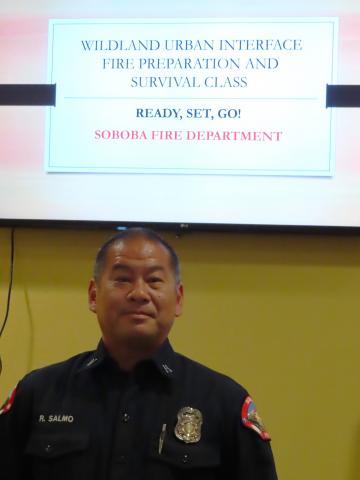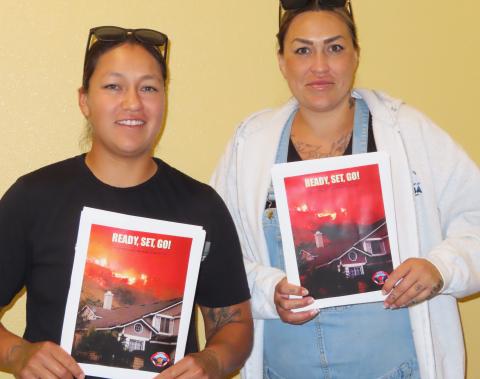To assist those who live and work on the Soboba Indian Reservation, Soboba Fire Captain Roger Salmo presented three classes in June to provide education and safety tips. The Wildland Urban Interface Fire Preparation and Survival Class was offered at no cost to participants through a grant from Cal Fire.
Focusing on preparation for those living and working close to nature, the classes outlined what to do before, during and after a WUI fire. These classes were scheduled after a need was identified to offer more communication about health and safety for residents. With the resources gained from three grants, much headway has been made in addressing the potential fire issues in the area.
Members of the Traditional Land Resources Management Crew, otherwise known as the Canyon Crew, cut back overgrowth on the west side of the reservation, which is the major point where a wildfire would enter the area. Another grant provided for dissemination of information through an automated text system. The third grant will help implement a nationwide program that can be adapted to any emergency – flood, earthquake, fire, etc.
A Tribal Emergency Response Team/Community Emergency Response Team basic training class will be offered in September. CERT training is a Federal Emergency Management Agency training class that will educate residents about disaster preparedness for the hazards that will impact their community. Participants will be trained in basic disaster response skills such as fire safety, light search and rescue, team organization and disaster medical operations. Those who complete the three-day class and all units and exercises, will receive a certificate and CERT backpack.
Capt. Salmo said the purpose of the upcoming readiness training, as well as June’s classes on “Ready, Set, Go!,” is to make sure everyone is prepared and knows each person can make a difference.
Soboba Fire Chief Glenn Patterson said that wildfire is a serious threat to lives, property and natural resources in California.
“The men and women of Soboba Fire make countless preparations and train frequently in order to be ready for all types of emergencies,” he said, adding that residents can dramatically increase their safety and the survivability of their property by preparing well in advance of a wildfire.
Statistics from FEMA show that more than 46 million residents in 70,000 communities are at risk of wildfires and almost 90% of wildland fires are caused by people.
Salmo described the importance of defensible space, which is what firefighters need to protect properties. The buffer created by removing weeds, brush and other vegetation helps keep the fire away from the home and reduces the risks from flying embers. He said that ember fires can destroy homes or neighborhoods far from the actual flame front of a wildfire.
Defensible space is the required space between a structure and the wildland area that, under normal conditions, creates a sufficient buffer to slow or halt the spread of wildfire to a structure. It consists of two zones, the first one extending 30 feet out from the buildings. All dead or dying vegetation should be removed, tree canopies should be trimmed and branches should be kept a minimum of 10 feet from structures and other trees. Leaf litter such as dry leaves and pine needles should be removed from the yard, roof and rain gutters.
Woodpiles or other combustible materials should be removed or moved further from the structure. “Ladder fuels” which is low-level vegetation that allows the fire to spread from the ground to the tree canopies, should be removed as well as any vegetation near windows.
The second zone extends 30 to 100 feet out from buildings, structures and decks. It is important to remove ladder fuels in this area as well, plus cut or mow grass to a maximum height of four inches.
The important first step is to get “Ready” by creating various checklists to help prepare a Wildfire Action Plan and practice the plans regularly so the entire family knows what to do. A Family Disaster Plan should include meeting locations and communication plans, including evacuation of large animals. Have fire extinguishers on hand and train all family members how to use them. Learn where all the utility shut-off controls are and how to use them. Plan several different evacuation routes. Assemble an emergency supply kit for the home and one for the car. Appoint an out-of-area friend or relative as a point of contact and have a portable radio or scanner that can provide updates on the fire.
As the fire approaches “Get Set” by alerting family and neighbors and making sure everyone is wearing appropriate clothing and has picked up the emergency supply kit. All windows and doors should be shut but left unlocked; flammable window shades and curtains should be removed; flammable furniture should be moved to the center of the room, away from windows and doors; gas and pilot lights should be shut off as well as air conditioning units, but lights should be left on so firefighters can see under smoky conditions.
The outdoors checklist should contain gathering up flammable items from the exterior of the home such as toys for children and pets, door mats and patio furniture and taking them inside; propane tanks should be turned off while exterior lights should be turned on; have a ladder available; seal attic and ground vents with pre-cut plywood or commercial seals if time permits to avoid embers entering the home; continue to patrol your property and extinguish all small fires until you leave, but always evacuate when authorities tell you to do so. Back your vehicle into the driveway but leave all doors and windows shut.
Create a checklist in case the unfortunate circumstance arises of being unable to leave the area. Items include knowing to shelter away from outside walls, bring garden hoses inside the house so embers don’t destroy them, patrol inside your home for spot fires and extinguish them, wear long sleeves and long pants made of natural fibers such as cotton, stay hydrated, fill sinks and tubs for an emergency water supply and place wet towels under doors to keep smoke and embers out. After the fire has passed, check your roof and extinguish any fires, sparks or embers; check inside the attic for hidden embers; patrol your property and extinguish small fires. If there are fires that you cannot extinguish with a small amount of water or in a short period of time, call 911.
It is recommended to “Go” early, which gives you the best chance of surviving a wildfire and helps firefighters by keeping roads clear of congestion. Leave to a predetermined location and have several travel routes mapped out in case one is blocked by fire or emergency vehicles and equipment. Take your emergency supply kits containing all necessary items for your family and pets.
The American Red Cross recommends assembling a supply kit long before a wildfire or other emergency occurs. A checklist is helpful to be sure nothing is overlooked. The following commonly needed items should be included: three-day supply of water, one gallon per person per day; three-day supply of non-perishable food for all family members and pets that can be accessed easily (pop-top cans, bags, boxes); first-aid kit; flashlight, battery-powered radio and extra batteries; an extra set of car keys, credit cards and cash; sanitation supplies; extra eyeglasses or contact lenses; important family documents and contact numbers; a map marked with evacuation routes; prescriptions or special medications; family photos and other irreplaceable items; easily carried valuables; personal computers; and chargers for all electronic devices. It is advised that a pair of old shoes and a flashlight be kept handy in case of a sudden evacuation at night.
Salmo also explained that the best course of action is prevention and that creating fire-resistant landscaping and using the right type of construction materials on structures gives homes the best chance of surviving a wildfire. He also said that reservation residents can request assistance from the Soboba Fire Department and Canyon Crew in learning how to create proper defensible spaces.
For more information, www.usfa.fema.gov/wui, www.redcross.org or www.fire.soboba-nsn.gov.
Photos courtesy of the Soboba Band of Luiseño Indians



